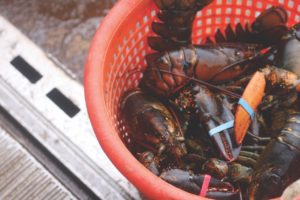The reports of dead lobsters being pulled from Cape Cod Bay started on Sept. 23. The cause: warmer than average late fall water temperatures and low wave action that led to “unprecedented” low levels of oxygen in the water.
That day the Mass. Div. of Marine Fisheries began getting reports of dead lobsters coming up in traps off Sandy Neck Beach in Barnstable and Sandwich, according to Robert Glenn, a state aquatic biologist.
“The first day we got reports from a commercial lobsterman that he pulled up several dozen dead lobsters and some dead fish in his traps,” Glenn said. “The following day we got another seven or eight reports from fishermen in the same area with anywhere from dozens to hundreds of dead lobsters.”

The culprit was low dissolved oxygen (DO) content caused by stratified waters. Water tests looking for DO content found a “fairly broad swath” in Cape Cod Bay of hypoxic water conditions, defined as anytime dissolved oxygen levels drop below 2 milligrams per liter.
“That’s the lethal threshold for most aquatic animals — fish, crustaceans, and some bivalves,” said Glenn. His team found readings as low as 0.3mg/liter, which he said is “extraordinarily low.” In the surrounding areas DO levels were considered “stressful” but did not kill animals.
During the summer wind-driven mixing of the water column typically keeps it well oxygenated, with bottom temperatures ranging from 6 to 10 degrees Celsius (43 to 50 degrees F) over the course of a six-hour tidal cycle.
“Right around September, those patterns stop pretty abruptly,” Glenn explained. “Temperatures vary only two degrees during a tidal cycle, and there’s less vertical mixing in the water column.”
In early fall Cape Cod Bay is prone to drops in dissolved oxygen levels, but “we’ve never seen them drop below the 4 to 5 [milligrams] range in my 25 years here,” said Glenn.
“This stratification is the same general phenomenon we’re seeing in the ponds,” said Andrew Gottlieb, executive director of the Association to Preserve Cape Cod. “Warming layers are getting thicker on the top and the time period when they don’t mix with heavier, cooler bottom waters is lasting longer, causing anoxic situations.”
Gottlieb explained that the same warming average temperatures that are driving stratification are also promoting conditions that allow for more growth of algae in the water column, which in turn absorb more sunlight and heat, creating a feedback loop.
The Association to Preserve Cape Cod recently released its 2019 State of the Waters report, in which the group states that more than two-thirds of Cape Cod’s coastal embayments and more than one-third of its freshwater ponds are suffering from unacceptable water quality due to excess nutrients.
“This means that areas that used to have clear water and healthy eel grass beds that served as nursery area for scallops and fin fish and produced the high levels of dissolved oxygen needed to support sensitive and very valuable fisheries resources can’t do that anymore,” said Gottlieb. “They can’t serve that resource function.”
Excess nutrients in the water are coming from septic system waste, storm water, and excessive fertilizer use on residential and commercial properties.
“If this is unmixed water because of warming waters and it’s dragging in other culprits like runoff and nitrates as well, that’s worrisome,” said Damien Parkington, a Wellfleet lobsterman. “Lobstering just got a lot thrown at it, and right now anything extra like this event is extremely stressful.”
Beth Casoni, director of the Mass. Lobstermen’s Association, stressed in a phone call with the Independent that not all lobsters in the area were killed by the event.
“The only lobsters we’re seeing dead were the ones in the pots,” she said. “The state had divers out there and they did not see any dead species on the bottom. They can sense low oxygen — just like if we walked into an oxygen deprived room, we would leave. They’ve vacated the area.”
Casoni said lobstermen are relieved that there is no evidence of disease but will likely not return to fish the area this fall, as the inshore season usually winds down in late October or early November.
Mike Rego, a 20-year veteran of the Cape Cod Bay lobster fishery who lives in North Truro, said he’s seen changes in lobster migration patterns in recent years.
“Females come inshore to drop their eggs in the summer, and then they start to shed,” Rego explained. “They can only mate when the females are soft, so then the males come in to mate, and then they’ll migrate back offshore in the fall. Everything seems a little late this year. The spring was cold and then July was really warm, so we’re like three weeks behind on everything.”
Gottlieb said these kinds of disruptions are likely to become more frequent.
“We’ve introduced rapid warming at a time scale out of sync with the ability of the resources and the species that use them to adapt,” he said. “We’re doing a big fat experiment over which we have no control.”



